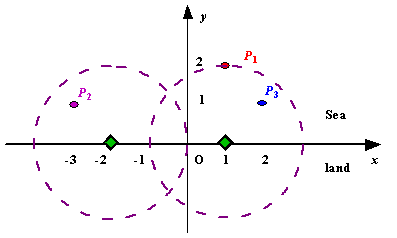Radar Installation
| Time Limit: 1000MS | Memory Limit: 10000K | |
| Total Submissions: 43793 | Accepted: 9704 |
Description
Assume the coasting is an infinite straight line. Land is in one side of coasting, sea in the other. Each small island is a point locating in the sea side. And any radar installation, locating on the coasting, can only cover d
distance, so an island in the sea can be covered by a radius installation, if the distance between them is at most d.
We use Cartesian coordinate system, defining the coasting is the x-axis. The sea side is above x-axis, and the land side below. Given the position of each island in the sea, and given the distance of the coverage of the radar installation, your task is to write a program to find the minimal number of radar installations to cover all the islands. Note that the position of an island is represented by its x-y coordinates.

Figure A Sample Input of Radar Installations
We use Cartesian coordinate system, defining the coasting is the x-axis. The sea side is above x-axis, and the land side below. Given the position of each island in the sea, and given the distance of the coverage of the radar installation, your task is to write a program to find the minimal number of radar installations to cover all the islands. Note that the position of an island is represented by its x-y coordinates.

Figure A Sample Input of Radar Installations
Input
The input consists of several test cases. The first line of each case contains two integers n (1<=n<=1000) and d, where n is the number of islands in the sea and d is the distance of coverage of the radar installation. This is
followed by n lines each containing two integers representing the coordinate of the position of each island. Then a blank line follows to separate the cases.
The input is terminated by a line containing pair of zeros
The input is terminated by a line containing pair of zeros
Output
For each test case output one line consisting of the test case number followed by the minimal number of radar installations needed. "-1" installation means no solution for that case.
Sample Input
3 2 1 2 -3 1 2 1 1 2 0 2 0 0
Sample Output
Case 1: 2 Case 2: 1
这个题据说是贪心题,但是网上的解题报告看来看去,觉得更像是区间覆盖,然后自己就用这样的思路写了一下,结果就AC了,具体就是先将平面上的问题化成数轴上的问题,将平面每个点坐标得到后先进行判断,如果纵坐标大于雷达半径,则输出-1结束,如果不是,运用勾股定理计算在X轴修建雷达可以辐射的区间,用结构体point的两个值left以及right存储区间的左值以及右值,按左值从小到大对结构体point进行排序,将第一个雷达放置在最左边第一个区间内,并且判定位置放到第一个区间的右值,判断下一个点的左值是否在判定点左面,如果在,则此雷达可以同时扫描到该点,继续判定右值是否在该判定点左面,如果在,将判定点变为该点的右值,如果左值不在判定点左面,则需添加雷达,雷达数量加1,并且将判定点变为该点右值,直到结束所有点的判定后输出当前雷达数量。
下面是AC的代码:
#include<cstdio> #include<cmath> #include<iostream> using namespace std; struct st { double left; double right; }point[1005]; int x[1005],y[1005]; void sort(int n) { int i,j,k; st temp; for (i=0;i<n;i++) { k=i; for (j=i;j<n;j++) if (point[j].left<point[k].left) k=j; temp=point[i];point[i]=point[k];point[k]=temp; } } int main() { int i,time=1,num,flag,n,d; double r,temp; while(1) { num=1; flag=1; scanf("%d%d",&n,&d); if(n==0&&d==0) break; for(i=0;i<n;i++) { scanf("%d%d",&x[i],&y[i]); if(y[i]>d) flag=0; } if(flag==0) { printf("Case %d: -1\n",time); time++; } else { for(i=0;i<n;i++) { temp=sqrt(d*d-y[i]*y[i]); point[i].left=(double)x[i]-temp; point[i].right=(double)x[i]+temp; } sort(n); r=point[0].right; for(i=1;i<n;i++) { if(point[i].left<=r) { if(point[i].right<=r) r=point[i].right; } else { r=point[i].right; num++; } } printf("Case %d: %d\n",time,num); time++; } } return 0; }
























 1186
1186

 被折叠的 条评论
为什么被折叠?
被折叠的 条评论
为什么被折叠?








